Return to Glory: Notre Dame’s Restoration Is On Track
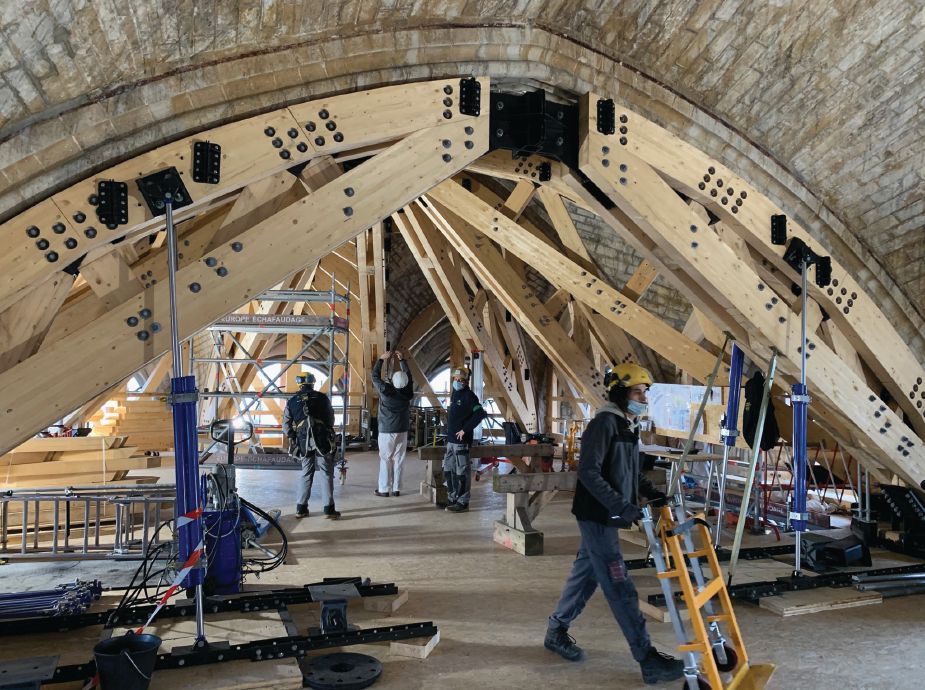
Interior bracing was installed during the safety phase to stabilize stone arches.
Notre Dame de Paris is not the largest Gothic cathedral in the world, or in France. It’s not even the largest cathedral named for “Our Lady” in France; Notre Dame de Amiens, Notre Dame de Chartres and Notre Dame de Reims are all larger and considered (by many) to be finer examples of Gothic architecture. And, to continue running down this UNESCO World Heritage Site for one more sentence, it’s not the oldest cathedral … even in Paris! That honor goes to the basilica of Saint-Pierre-aux-Nonnains, which began life as a Roman secondary school building in 380 AD and was converted into a church in the 7th century. Construction of Notre Dame de Paris began in 1163 and was completed circa 1270.
But enough petty nitpicking; absolutely no one denies that Notre Dame is the most famous and beloved of the cathedrals—drawing about 13 million visitors annually—and one of the most treasured of all the world’s great buildings … of any kind.
Perhaps it’s the history; Notre Dame’s famous bells have tolled for the coronation of Henry the VI as King of France, for Napoleon when he named himself Emperor and (in 1909) for the beatification of Joan of Arc. Maybe it’s the location; it’s difficult to beat an island in the Seine in the heart of Paris for stately magnificence. And surely it being the setting for Victor Hugo’s most-famous novel, The Hunchback of Notre-Dame, has something to do with it—the popularity of the book actually inspired previous massive renovation in the 19th century, including structural repair of the spire and flying buttresses.
For whatever reason, Notre Dame is special. And when it burned on April 15, 2019, and as film of the destruction spread all about the world virally, the societal impact was out of all proportion to its size or age. It was as if human culture itself had taken a gut punch.
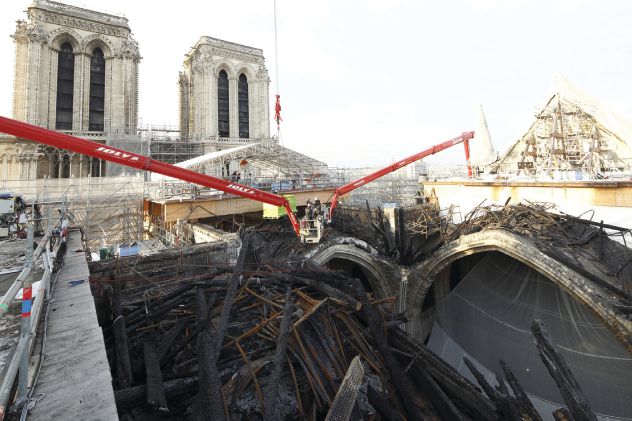
The main source of combustible material was Notre Dame’s famous “Forest”—massive beams made from 5,000 300- to 400-year-old oaks harvested circa 1200. Also shown is scorched scaffolding from ongoing restoration work at the time of fire.
Could Have Been Better, Could Have Been Worse
As grim and fearsome as the great cathedral’s burning looked on TV, when images of the aftermath emerged, many experts breathed a sigh of relief. Though tragic, actual destruction was confined mainly to the roof and the massive beams that supported it. The Notre Dame “Forest,” as it’s called, was a dense network made from old-growth trees—13th century builders harvested 5,000 oak trees from 52 acres of ancient forest, all 300 to 400 years old—to support the roof and its 200 tons of lead cladding as well as the cathedral’s 300-foot oak-and-lead central spire. All these old beams were more than 800 years old, perfectly dry, arranged with plenty of space and air around them, and functioned much like a vast latticework of kindling when flame was introduced.
The fire wasn’t entirely unexpected; though thankfully rare, cathedral fires and collapses happen, and—somewhat like a city aware enough to plan for a 500-year storm—elaborate fire detection and response plans were in place at Notre Dame. Perhaps too elaborate; a lot of things went wrong before they went right on 4/15, and for several hours there was real concern that not just the roof but most of the stone structure also would collapse—had this happened, the cathedral would have been effectively lost for all time.
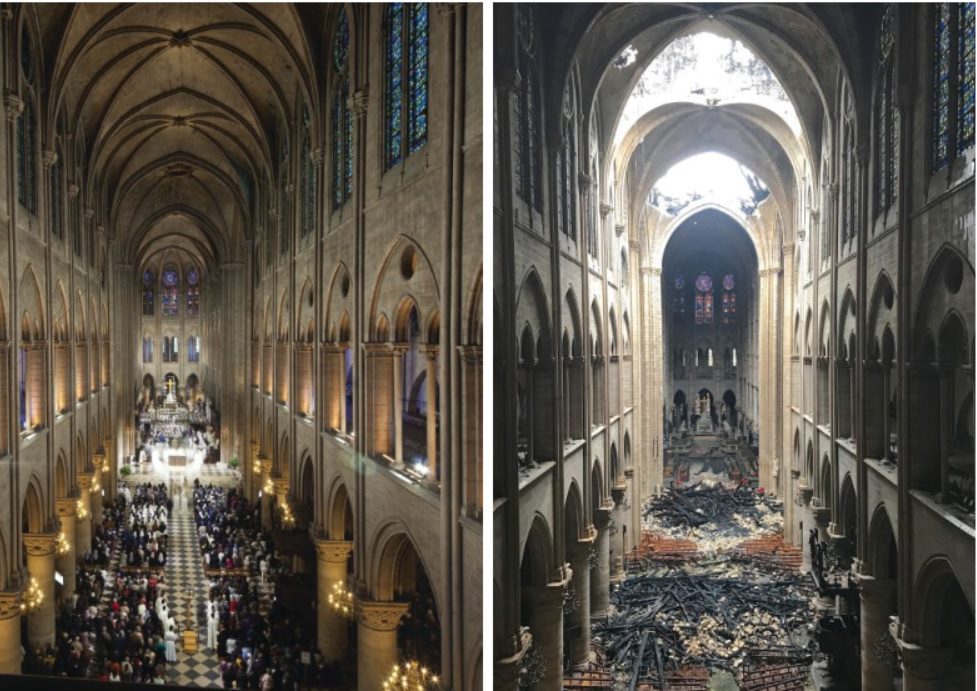
Before and after images of the cathedral interior demonstrate the surprising survival of art, relics and other features.
The full story of the fire’s beginning and first responder’s heroics is of interest to anyone involved in the maintenance of large infrastructure installations, and that story was exceedingly well told in The New York Times “Notre-Dame’s Safety Planners Underestimated the Risk, With Devastating Results,” a magnificent example of interactive multimedia journalism available free online (nyti.ms/3fFss7V). Of particular interest to Informed Infrastructure readers are the main reasons for the delayed response, which can be summed up as human error when interpreting a badly flawed monitoring system interface, compounded by a major mistake in risk assessment.
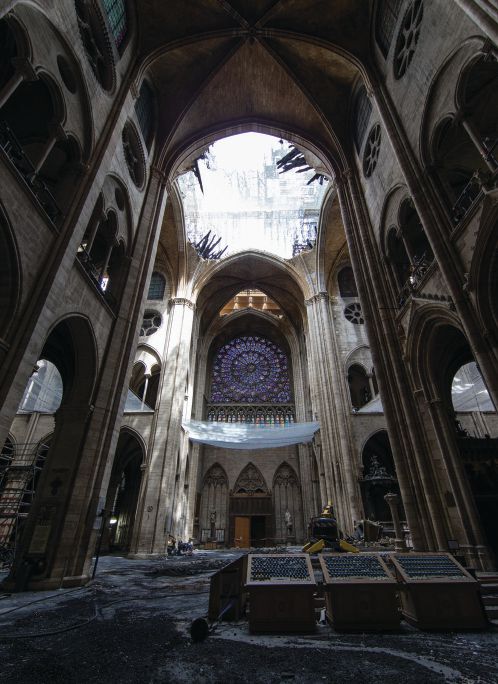
Although they will need cleaning and restoration, all stained-glass windows survived intact.
At about 6:10 p.m. on the night of the fire, a newly hired employee of the cathedral’s subcontracted security staff (just three days on the job) was sitting alone in a small, windowless room, looking at a control panel. He’d been mostly in that room since 7 a.m., and was in the middle of the back half of an unexpected double shift, when he received the following cryptic alert, in three parts:
Attic Nave Sacristy: This was a reference to a particular zone in the cathedral complex, the Forest.
ZDA-110-3-15-1: This was an indexing code for a particular smoke detector out of approximately 160 sensors and alarms placed in Notre Dame.
aspirating framework: This indicated an “aspirating detector”—basically, a smoke detector going off.
Note that the simple word “Feu!” (fire) nowhere appeared, nor anything like a schematic or plan of the cathedral interior with a sensor location marked.
To his credit, the new employee followed protocol and radioed a church guard to visually check for smoke and fire, who did so and saw nothing. To his everlasting shame—he has since received multiple death threats—he sent the guard to the wrong part of the cathedral, the attic of a small adjacent building called the sacristy, where there was no fire or smoke. Thirty minutes went by before the mistake was uncovered—at which point the guard was sent at a run up 300 narrow steps to the Forest, where he discovered an attic fire burning out of control. Here is where the mistake in risk assessment came in: both church officials and their fire-prevention subcontractors considered it nearly impossible for the Forest to go up in flames quickly, yet, in the event, it clearly did.
So the response, at least, could have been better.
Finally, the fire department was notified to deal with a “Forest” fire already out of control and beyond their ability to suppress. Only massive heroics by a small team of firefighters, and perhaps a miracle or two, prevented the collapse of the North Tower and belfry, which in turn prevented the collapse of the stone vaulting and most of the rest of the structure.
The Paris fire brigade should be commended not only for their cathedral-saving heroics, but for their skillful response overall, which closely adhered to plans and drills that had been in place for decades. With the main attic fire somewhat controlled they turned to preservation protocols which called for the use of relatively low hose pressure in zones with precious artifacts, avoiding spraying cold water on hot stained glass that could shatter ancient and irreplaceable windows, and the actual removal of particular artifacts.
By these means, an astonishing 90 percent of Notre Dame’s treasures and art escaped serious damage, including copper and marble statues, the stained-glass rose windows, the Crown of Thorns (arguably the most valuable relic in Christendom), the 300-year-old organ and its 8,000 pipes, and even chandeliers and many of the rattan chairs in the nave for services. And importantly, no lives were lost in the blaze, and injuries were minor.
So, it could have been worse.
Safety First
The fire burned overnight and was considered contained the next morning. That very afternoon, French President Emmanuel Macron declared that Notre Dame would be restored in five years, in time for the 2024 Paris Olympics. A laudable and ambitious goal, but was it possible?
“It’s a delicate question,” says Michel Picaud, the president of Friends of Notre-Dame de Paris, the charity fundraising to rebuild the church. “Opening the cathedral in 2024 won’t necessarily be the last step in the restoration,” he continues. “There’s more work to do. Everyone expects to enter the cathedral by 2024, but then it will continue after that date toward a full restoration.”
But before restoration and opening could even be contemplated, a lengthy safety phase had to be accomplished, overcoming two major challenges. The first was structure stabilization; the cathedral’s burnt shell was, in a word, rickety. Stabilization began with the removal of fire debris and scorched scaffolding (ironically, from restoration ongoing at the time of the fire); installation of new scaffolding and “half-hangers” to support fragile vaults; protective tarps wrapped around statues and gargoyles; installation of a temporary umbrella-like structure above the crossing of the transept, nave and choir to protect the interior from water damage; and the construction of a three-story structural metal-beam framework to prevent collapse. This structure was partly installed by workers dangling on ropes suspended overhead, which must have been an epic day on the job.
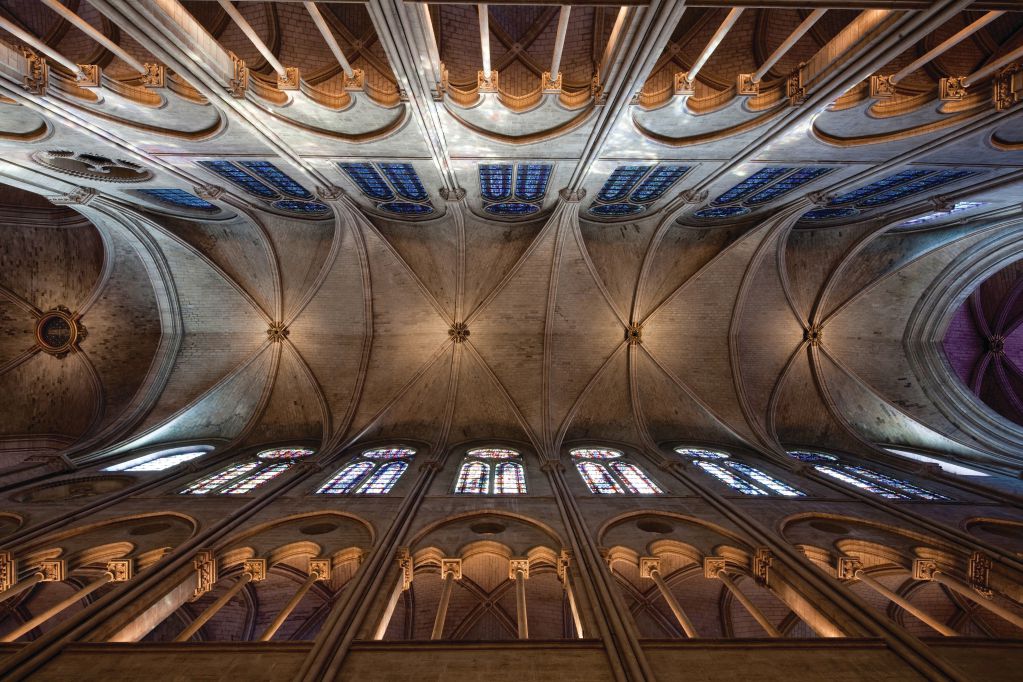
The collapsing attic “Forest” knocked several large holes into the cathedral’s lofty vaulting.
An interesting detail from this phase is the treatment of Notre Dame’s flying buttresses, built in 1180 and some of the earliest used in Gothic architecture. They’re a graceful way to laterally stabilize relatively thin outer walls (which made openings possible for the large stained-glass windows) by pushing back against outward forces from the stone arches that form the cathedral’s interior vault. But with the 300-ton (or so) roof and spire collapsed, and arches compromised, there was a real possibility that the buttresses now would do their job too well and knock walls over from the outside. This issue was addressed with the construction of huge, wooden, crescent-shaped “clamps,” installed on the underside of buttresses to neutralize lateral movement.
The second major safety challenge is simple to understand, but devilishly difficult to do anything about: lead contamination. About 450 tons of lead, mainly from the roof and spire, were released in temperatures exceeding 800 Celsius (1,472 Fahrenheit) on 4/15, either explosively melting into gobbets of molten metal and raining down on all the cathedral’s interior surfaces (and running in little rivulets into the Seine), or actually vaporized (as evidenced by the yellow tinge of the fire’s thick smoke) into a “toxic fallout” dispersed over much of Paris.
For the site itself, mitigation was straightforward, if tedious; work was done in hazmat suits and ventilators, and virtually all surfaces were vacuumed and wiped down with the equivalent of moist towelettes. For Paris and the Seine … well, it’s a difficult problem. The French government initially downplayed the specter of widespread contamination, but soil sampling and isotopic analysis (which can identify the particular lead used at Notre Dame) strongly suggests that fire-caused lead contamination will affect the river and Parisians for generations.
A third important safety challenge emerged about a year after the fire—the pandemic halted work for about three months. This obviously affected the schedule, but work did resume, and, according to Picaud, “We are pleased with the stabilization and security of the cathedral structure, and consider the safety phase complete as of July 2021.”
Traditional Renovation, After Some Crazy Talk
Macron’s initial speech promising reconstruction in five years left open the possibility of a non-traditional replacement roof and spire, and design firms worldwide responded with proposals for steel or concrete beams and trusses, recycled plastic construction, glass and stained-glass roof and spire, a gigantic swimming pool, a public park and greenhouse, a luxury penthouse apartment(!), and even a giant inflatable balloon.
Some of these proposals were quite beautiful and were taken seriously, and all came with renderings and sketches that were at least amusing. But alas, they all come to nothing in July 2020 when President Macron, in response to public outcry, decreed that Notre Dame’s oak and lead roof and spire would be restored as closely as possibly to their original state (i.e., as they were after the 19th century restoration that repaired the roof and rebuilt the spire). This was partly because, “The monument’s roof structure needs a very specific weight for the building to be stable: A combination of wood and lead is the ideal mix,” according to director of Notre Dame, Patrick Chauvet. In addition, the feeling seems to be, lead is great for roofs … so long as they don’t burn.
This meant, most obviously, replacing all the lead roofing and the massive oak beams that made up the Forest, a project decried immediately by environmental groups worldwide as an unconscionable strain on forests, even an “ecocide.” French forestry professionals countered that sufficient old-growth oaks were available and represented only about 0.1 percent of the annual harvest. And Michel Druilhe, president of France Bois Forêt said, “Given the place occupied by the cathedral in the hearts of the French, in the history of France and the world … we are happy [that] the entire industry—from foresters to sawyers—is mobilized to meet this challenge.”
Ultimately the 2,000 large oaks needed were harvested from more than 200 French forests, mostly in March 2020 (March harvest is optimum for sap and moisture reasons). Many were 200-year-old trees more than 60 feet long and 3 feet in diameter, from which correctly sized beams could be made. Eight massive trees in particular, all destined for the reconstructed spire, were taken from the Forest of Bercé that once belonged to the kings of France.
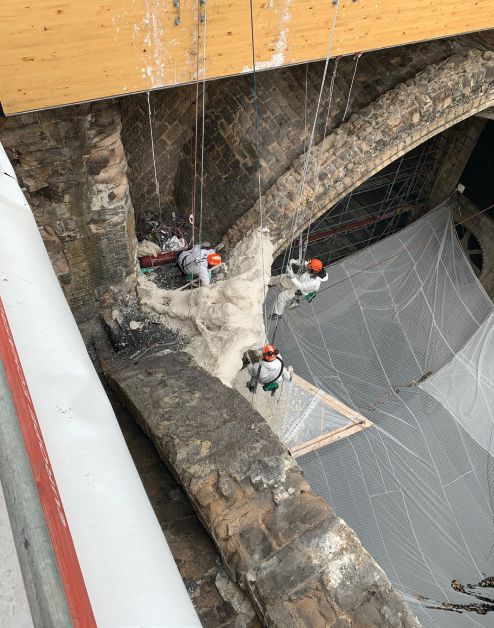
Workers and archaeologists dangling from ropes have been an important feature of the working safety phase.
Repair of fallen arches and stone vaulting is another major challenge. The hope is to reuse as many of the fallen limestone ashlars as possible, and all were removed (some by robot) to an offsite location for cleaning, sorting (guided partly by high-precision laser scanning, completed in 2005 by the late Professor Andrew Tallon) and analysis. Some stones won’t make the cut; high fire temperatures can permanently weaken limestone. Color is being as used as part of this analysis: At 300°C to 400°C, iron crystals that help knit the limestone together begin to break down, turning the surface red; at 600°C, the color changes again as the crystals are transformed into a black iron oxide; and by 800°C, the limestone loses all its iron oxides and becomes powdery lime. Some stones can be rehabilitated; soaked stones (limestone is porous and soaks up hose water), for example, can be dried out over months.
On the plus side, an ancient plaster coating on vaults and columns held up quite well and protected stonework. With careful work, it’s expected that all columns, arches and vaulting will be restored to exact original visual appearance, and be stronger than before due to the now-possible forensic analysis of original construction methods, improved layout techniques and the use of better materials such as fiber-reinforced grout.
Most art, treasures, statues, windows, relics and other interior features also have been moved offsite for lead decontamination, repair and restoration. Even ash from the fire was bagged up and taken elsewhere for sifting by archaeologists. All of this is tedious work, being done by masked and suited specialists working long hours; it’s one of largest and best-funded restoration projects ever attempted.
In my research and interviews for this article, I was continually impressed—overwhelmed almost—by the reverence, dedication and elan being shown by everyone involved. Michel Picaud, for example, spoke with great emotion about being a Notre Dame parishioner and living for a time in an apartment with a view of the famous Rose Window—this personal attachment absolutely drives his extraordinary efforts in fundraising and oversight, just as France’s national attachment to this Gothic marvel makes superb and faithful restoration a certainty. Notre Dame will rise again.
About Angus Stocking
Angus Stocking is a former licensed land surveyor who has been writing about infrastructure since 2002 and is the producer and host of “Everything is Somewhere,” a podcast covering geospatial topics. Articles have appeared in most major industry trade journals, including CE News, The American Surveyor, Public Works, Roads & Bridges, US Water News, and several dozen more.


